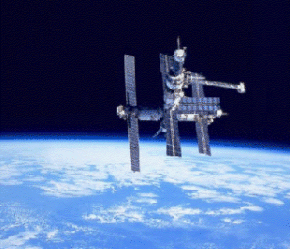
|
|
|
|

MIR IS COMING HOME, FOREVER.
Once it falls, and is destroyed in the atmosphere, it can obviously never be seen again. All Planet, and our friends, strongly believe that in the not too distant future, when people are enroute to the moon or Mars, that this monument would be a highlight to fly past.
We are very saddened to see this end of a "First Era" relic destroyed, and although we strongly support the incredible ISS - International Space Station, we wish there could have been a way to not kill off MIR in order to assure full attention to ISS. Times are very hard in Russia, and funding for Space Exploration is always critical. Nonetheless, we felt there could have been a way structured for both to occur, and for Russia to not need to bear any further investment in preserving MIR's orbit, while still being a strong participating party in the ISS project.
Mr. Bush, Mr. Putin? Anybody want to jump in here at the final
hours!

Click here to see where MIR is this moment
When the space station Mir returns to Earth over the remote South Pacific
later this month, it will be big news. And rightly so. The 135-ton Russian
outpost is the heaviest thing orbiting our planet other than the Moon itself.
During its 15-year stint in space, Mir has set endurance and space-adventure
records that are going to be hard to beat.
But among scientists who monitor the near-Earth environment,
an encounter with a 135 ton object from space is, well.... all in a day's
work.
"Asteroids weighing as much as Mir hit Earth perhaps 10 times
each year," says Bill Cooke, a member of the Space Environments team at
the Marshall Space Flight Center's Engineering Directorate. "We know this
because we observe the flashes of the explosions in the upper atmosphere
via Department of Defense satellites."
Just last year a 200-ton asteroid startled Canadians with a sonic
boom and a brilliant fireball as it disintegrated above the Yukon territory.
Scientists later recovered a smattering of meteorites from nearby Lake
Tagish, none larger than a few hundred grams.
"If a [rocky] asteroid with the same mass as Mir hit the ground
it would explode like a few kilotons of TNT, gouging out a crater about
the size of a football field," noted Cooke. However, Mir will never make
it that close to the ground. As Cooke explained, "the atmosphere is very
good protection and it breaks up meteorites and other space objects well
before impact."
Indeed, if Mir were an asteroid, it wouldn't merit classification
as a potentially hazardous one. In the cosmic scheme of things, Mir is
simply too small.
Nevertheless, scientists expect the space station to put on a
good show when it returns.
Mir is put together much like an erector set. It's a beautiful
but gangly-looking assortment of solar arrays, laboratories and living
quarters -- obviously not designed for aerodynamic flight through the atmosphere.
The station will quickly fall apart as it descends toward Earth.
"We expect Mir to break into six or more main pieces when it
hits the atmosphere," says Nicholas Johnson, chief scientist and program
manager for orbital debris studies at NASA's Johnson Space Center. Each
piece will resemble a blazing comet that spits smaller fireballs as the
pieces crumble and burn.
Below: These computer simulated images of Mir's descent and breakup
appear courtesy of Analytical Graphics, Inc., the makers of Satellite Toolkit.
Cosmonauts assembled Mir piece-by-piece during a busy ten year
period beginning in 1986. The station's modules include the voluminous
Core, Mir's original 20-ton segment that harbors the crew's living quarters;
plus Spektr, a 19-ton science laboratory famous for its 1997 collision
with a Progress spacecraft; and the 19-ton Priroda Earth observatory, launched
only five years ago.
Five of Mir's modules are still pressurized with air inside for
humans. When they explode, sky watchers (mainly sea birds) could witness
a once-in-a-lifetime display as the incandescent fragments streak across
the sky.
"Of Mir's 135 tons, the Russians say about 20 tons might reach
the surface -- mostly in small pieces," noted Johnson.
Even now Mir is sinking 1.5 km each day because of atmospheric
drag. Left to itself, the station would naturally plunge to Earth from
its 250 km orbit no later than March 28th. But that would be an uncontrolled
descent. Instead, Mir will be guided to its final resting place by a Progress
spacecraft attached to the station.
On March 20th Russian ground controllers plan to fire the Progress's
engines when Mir is at apogee -- its greatest distance from Earth. "The
engine firing will move perigee [Mir's closest approach to our planet]
to a point inside the atmosphere over the south Pacific," explained Johnson.
"That's where the station's fragments will land."
"With a controlled deorbit it doesn't matter if 20 tons or the
whole 135 tons reaches the surface -- the risk to people or property should
be essentially zero," says Johnson. Mir's descent is certainly safer than
the many uncontrolled encounters we experience with Mir-weight asteroids
each year.
Above: Visit NASA Liftoff's JTrack to find out where Mir is now.
The program should give accurate results until the Progress-guided descent
of Mir begins on or about March 20th.
No one knows more about dumping spacecraft in the remote Pacific
than the Russians. Since 1978 they've deorbited 80 Progress spacecraft
and five Salyut space stations in the same area. "Two Progress spacecraft
have gone down there already this year," says Johnson. "Mir, which is attached
to a Progress, will be the third."
"The most recent space station to descend over the Pacific was
Salyut 6," he added. "That weighed 40 tons and came down in July of 1982.
The deorbiting technique is exactly the same -- Mir's just a bit bigger."
Dont miss this related story:
Link to Interview with
American Astronauts and
Russian Cosmonauts ISS TEAM
28 K (Low Speed)
or 56K (Higher Speed)
| WANT MORE?
Visit this page and links to more information on the MIR COMES HOME AND DIES Topic |
|
More info on VX2000 |

Click here to visit The Making of... site featuring a small part of our work with the Hollywood Studios
Click here
to visit LOONEY PICTURE'S New site @
LooneyPictures.com
Click here to visit our favorite HUMOR site @
Stop Wasting Time.com
Some FRIENDS of ALL PLANET are hosted by us. For those of you wanting to research a name or start a site on the WEB, feel free to use these links:
All Planet Affiliate Program at INTERNIC, Network Solutions
a division of ALL PLANET NETWORK
ALL PLANET Incorporated
all rights reserved
Gabreal Franklin Associates reserve intelectual property
on selected materials
